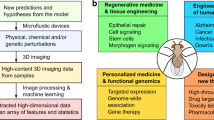Abstract
A method for assembling Drosophila embryos in a microfluidic device was developed for studies of thermal perturbation of early embryonic development. Environmental perturbation is a complimentary method to injection of membrane-impermeable macromolecules for assaying genetic function and investigating robustness in complex biochemical networks. The development of a high throughput method for perturbing embryos would facilitate the isolation and mapping of signaling pathways. We immobilize Drosophila embryos inside a microfluidic device on minimal potential-energy wells created through surface modification, and thermally perturb these embryos using binary laminar flows of warm and cold solutions. We self-assemble embryos onto oil adhesive pads with an alcohol surfactant carrier fluid (detachment: 0.1 mL/min), and when the surfactant is removed, the embryo-oil adhesion increases to ∼25 mL/min flow rates, which allows for high velocities required for sharp gradients of thermal binary flows. The microfluidic thermal profile was numerically characterized by simulation and experimentally characterized by fluorescence thermometry. The effects of thermal perturbation were observed to induce abnormal morphogenetic movements in live embryos by using time-lapse differential interference contrast (DIC) microscopy.











Similar content being viewed by others
References
M.D. Abramoff, P.J. Magelhaes et al., Biophoton. Int. 11(7), 36–42 (2004)
J.R. Anderson, D.T. Chiu et al., Anal. Chem. 72(14), 3158–3164 (2000)
R.W. Bernstein, X.J. Zhang et al., μTAS (Nara, Japan, 2002)
K. Brakke, Surface Evolver is an Interactive Program for the Modeling of Liquid Surfaces Shaped by Various Forces and Constraints (Mathematics Department, Susquehanna University, Selinsgrove, PA, 2005)
T.D. Brown, J. Biomech. 33(1), 3–14 (2000)
R.W. Carthew, Curr. Opin. Cell Biol. 13(2), 244–248 (2001)
F. Caruso, H. Lichtenfeld et al., J. Am. Chem. Soc. 120(33), 8523–8524 (1998)
D. Debarre, W. Supatto et al., Opt. Lett. 29(24), 2881–2883 (2004)
A. Eldar, B.Z. Shilo et al., Curr. Opin. Genet. Dev. 14, 435–443 (2004)
J. Fang, K.F. Böhringer, J. Micromechanics Microengineering 16, 721–730 (2006)
V. Foe, B.M. Alberts, J. Cell Sci. 16(1), 31–70 (1983)
E. Freire, T. Coelho-Sampaio, J. Biol. Chem. 275(2), 817–822 (2000)
V. Girish, A. Vijayalakshmi, Indian J. Cancer 41(1), 47 (2004)
B.A. Grzybowski, X. Jiang et al., Phys. Rev. E Stat. Nonlin. Soft. Matter. Phys. 64(1 Pt 1), 011603 (2001)
Halocarbon-Products-Corporation Frequently Asked Questions, about Halocarbon 700 (2006)
A. Hatch, A.E. Kamholz et al., Nat. Biotech. 19(5), 461–465 (2001)
R.F. Ismagilov, A.D. Stroock et al., Appl. Phys. Lett. 76(17), 2376–2378 (2000)
A.E. Kamholz, B.H. Weigl et al., Anal. Chem. 71(23), 5340–5347 (1999)
K. Kendall, J. Phys. D: Phys. 4, 1186–1195 (1971)
E.M. Lucchetta, J.H. Lee et al., Nature 434(7037), 1134–1138 (2005)
E.M. Lucchetta, M.S. Munson et al., Lab. Chip. 6(2), 185–190 (2006)
Microchem-Corporation. SU8-2000 Photoresist Technical Literature. (2006)
J. Niemuth, R. Wolf, Dev. Genes Evol. 204(7–8), 444–452 (1995)
C. Nusslein-Volhard, E. Wieschaus, Nature 287(5785), 795–801 (1980)
S.R. Oliver, T.D. Clark et al., J. Am. Chem. Soc. 123(33), 8119–8120 (2001)
N.A. Peppas, J.J. Sahlin, Biomaterials 17(16), 1553–1561 (1996)
G.M. Rubin, E.B. Lewis, Science 287(5461), 2216–2218 (2000)
U. Srinivasan, D. Liepmann et al., J. MEMS 10(1), 17–24 (2001)
C.E. Stauffer, J. Phys. Chem. 69(6), 1933–1938 (1965)
M. Sugihara-Seki, Biorheology 37(5–6), 341–359 (2000)
M. Sugihara-Seki, Biorheology 38(1), 3–13 (2001)
J.J. Talghader, J.K. Tu et al., IEEE Photonics Technol. Lett. 7(11), 1321–1324 (1995)
G.M. Walker, H.C. Zeringue et al., Lab. Chip. 4(2), 91–97 (2004)
X. Xiong, Y. Hanein et al., J. MEMS 12(2), 117–127 (2003)
H.J. Yeh, J.S. Smith, IEEE Photonics Technol. Lett. 6, 706–708 (1994)
G. Yucel, S. Small, Curr. Biol. 16(1), R29–R31 (2006)
X.J. Zhang, C.-C. Chen et al., J. MEMS 14, 1187–1197 (2005)
Acknowledgements
We would like to thank Welch Foundation, SPRING, and the Center for Nano and Molecular Science and Technology (CNM) at UT Austin for their facilities including the goniometer setup. We would also like to thank Professor Grant Wilson and Dr. Peter Carmichael for their discussions on surfactants and interfacial tension, and Ashwini Gopal for facilitating the fabrication of the self-assembly pads suitable for DIC imaging. This study was supported in part by the March of Dimes Basil O1Connor Award and the National Institute of Health, grant RO1GM067013 (to J.C.S) and the National Science Foundation Nanoscale Exploratory Research Program ECS-0609413 (to X.J.Z).
Author information
Authors and Affiliations
Corresponding author
Rights and permissions
About this article
Cite this article
Dagani, G.T., Monzo, K., Fakhoury, J.R. et al. Microfluidic self-assembly of live Drosophila embryos for versatile high-throughput analysis of embryonic morphogenesis. Biomed Microdevices 9, 681–694 (2007). https://doi.org/10.1007/s10544-007-9077-z
Published:
Issue Date:
DOI: https://doi.org/10.1007/s10544-007-9077-z




